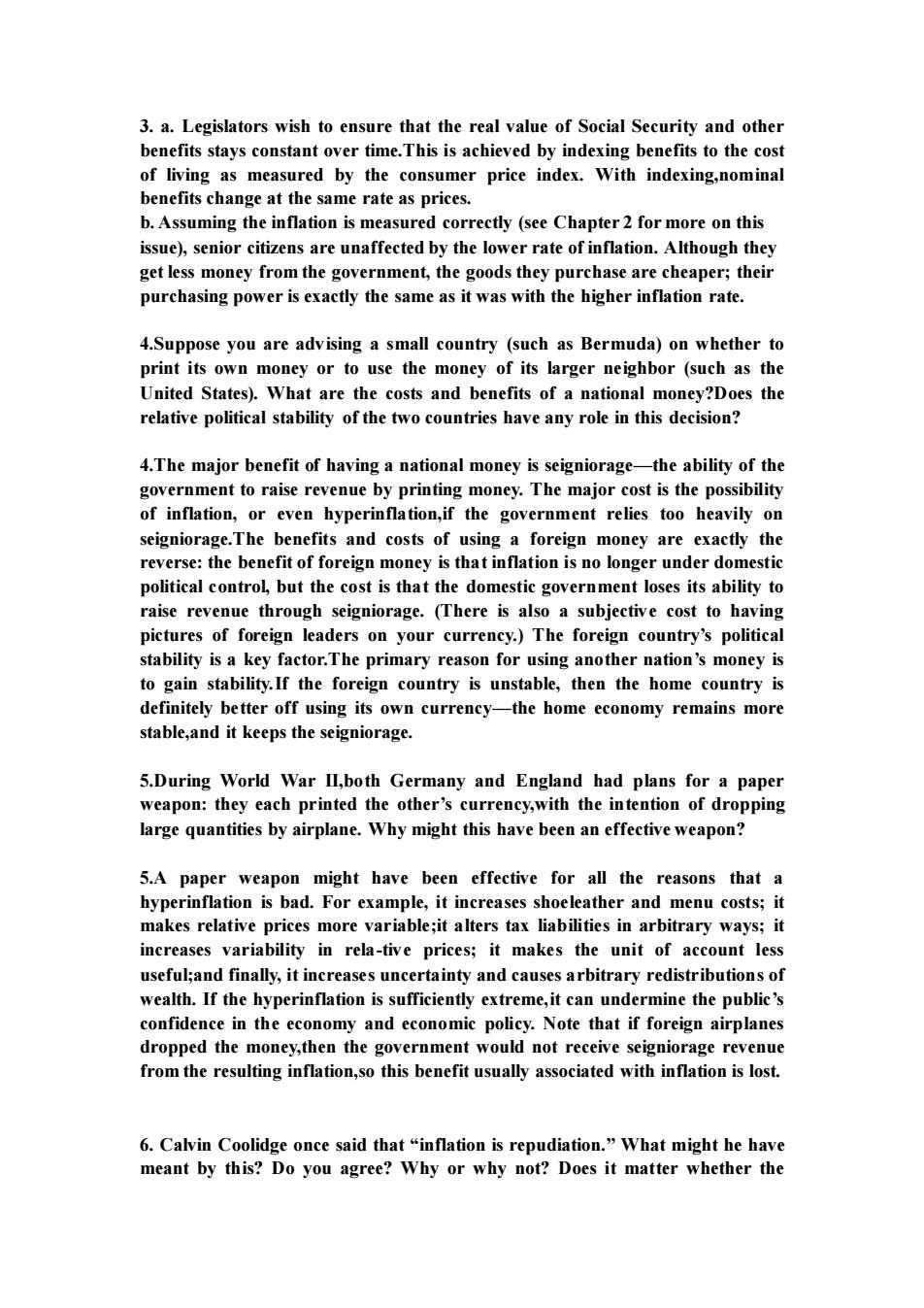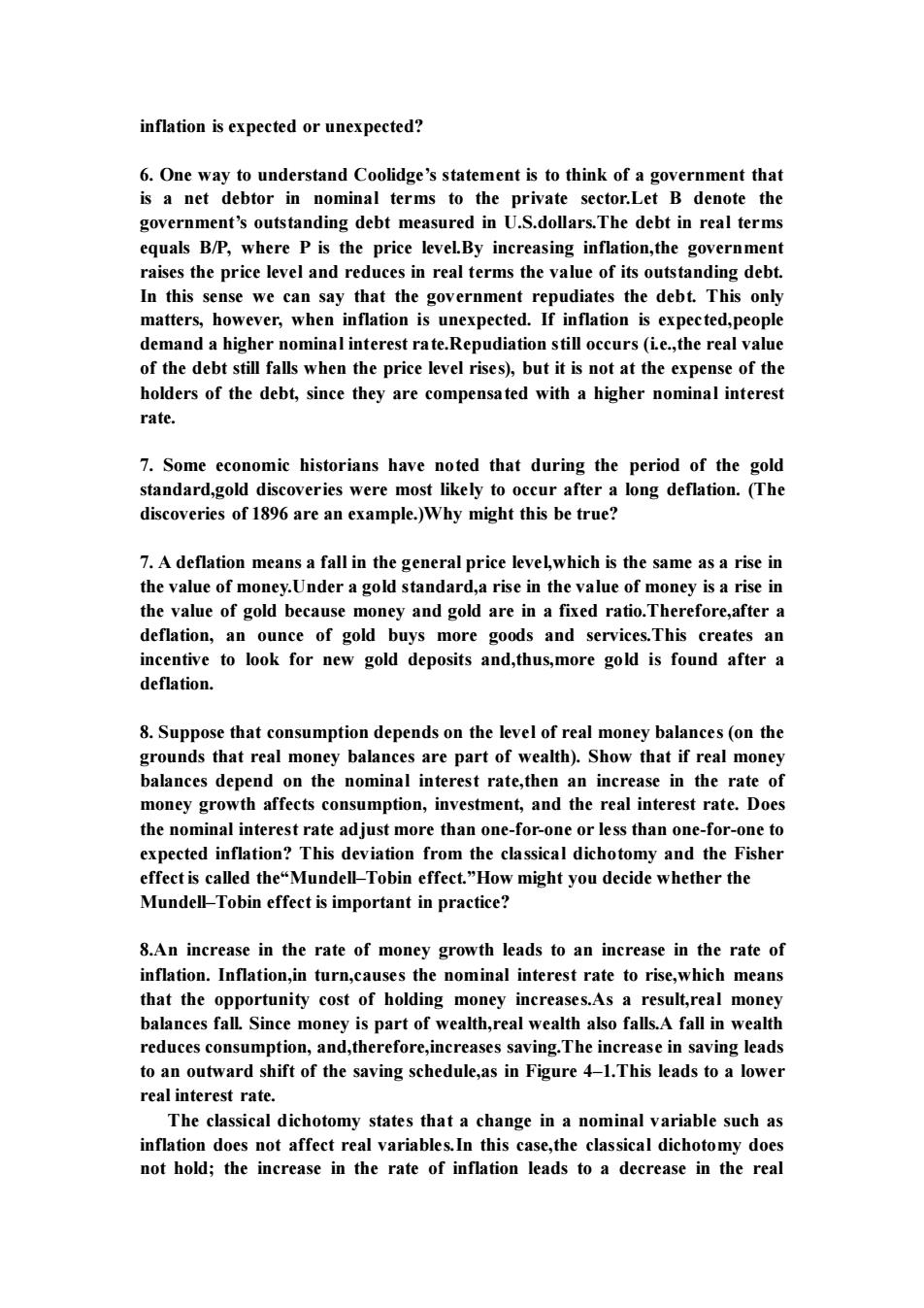
3.a.legislators wish to ensure that the real value of Social security and other stays constant time.This is achieved by inde s to the co of living as measured by the consumer price index.With xing,nomina benefits change at the same rate as prices. b.Assuming the inflation is measured correctly(see Chapter 2 for more on this issue),senior citizens are unaffected by the lower rate of inflation.Although they get less money from the m nt.the e goods the aper .thei purchasing power is exactly the same as it was witl higher inflation rate 4.Suppose you are advising a small country (such as Bermuda)on whether to print its own money or to use the money of its larger neighbor (such as the United States).What are the costs and benefits of a national money?Does the relative political tability of the two countries have any role in this 4.The major benefit of having a national money is seigniorage-the ability of the government to raise revenue by printing money.The major cost is the possibility of inflation,or even hyperinflation,if the government relies too heavily on seigniorag The efit s and costs of u ising ign oney are the reverse:the bene efit of f oreign money is that infation is no long political control,but the cost is that the domestic government loses its ability to raise revenue through seigniorage.(There is also a subjective cost to having pictures of foreign leaders on your currency.)The foreign country's political stability is a key factor.The prima reason for using another nation's ney is gain stability.If the foreign country is uns e,then the home country is definitely better off using its own currency-the home economy remains more stable,and it keeps the seigniorage. 5.During World War I,both Germany and England had plans for a paper weapon the ach printed the othe vith the int pping large quantities by airplane.Why might this have been an effective weapon? 5.A paper weapon might have been effective for all the reasons that a hyperinflation is bad.For example,it increases shoeleather and menu costs;it makes relative prices more variable;it alters tax liabilities in arbitrary ways;it increases variability in rela-tive prices;it makes the unit account les useful;and finally,it increases uncertainty and causes arbitrary redistributions of wealth.If the hyperinflation is sufficiently extreme,it can undermine the public's confidence in the economy and economic policy.Note that if foreign airplanes dropped the money,then the nment w ould not receive seignio ige revenue from the tion,so efit usually associated with n is 6.Calvin Coolidge once said that "inflation is repudiation."What might he have meant by this?Do you agree?Why or why not?Does it matter whether the
3. a. Legislators wish to ensure that the real value of Social Security and other benefits stays constant over time.This is achieved by indexing benefits to the cost of living as measured by the consumer price index. With indexing,nominal benefits change at the same rate as prices. b. Assuming the inflation is measured correctly (see Chapter 2 for more on this issue), senior citizens are unaffected by the lower rate of inflation. Although they get less money from the government, the goods they purchase are cheaper; their purchasing power is exactly the same as it was with the higher inflation rate. 4.Suppose you are advising a small country (such as Bermuda) on whether to print its own money or to use the money of its larger neighbor (such as the United States). What are the costs and benefits of a national money?Does the relative political stability of the two countries have any role in this decision? 4.The major benefit of having a national money is seigniorage—the ability of the government to raise revenue by printing money. The major cost is the possibility of inflation, or even hyperinflation,if the government relies too heavily on seigniorage.The benefits and costs of using a foreign money are exactly the reverse: the benefit of foreign money is that inflation is no longer under domestic political control, but the cost is that the domestic government loses its ability to raise revenue through seigniorage. (There is also a subjective cost to having pictures of foreign leaders on your currency.) The foreign country’s political stability is a key factor.The primary reason for using another nation’s money is to gain stability.If the foreign country is unstable, then the home country is definitely better off using its own currency—the home economy remains more stable,and it keeps the seigniorage. 5.During World War II,both Germany and England had plans for a paper weapon: they each printed the other’s currency,with the intention of dropping large quantities by airplane. Why might this have been an effective weapon? 5.A paper weapon might have been effective for all the reasons that a hyperinflation is bad. For example, it increases shoeleather and menu costs; it makes relative prices more variable;it alters tax liabilities in arbitrary ways; it increases variability in rela-tive prices; it makes the unit of account less useful;and finally, it increases uncertainty and causes arbitrary redistributions of wealth. If the hyperinflation is sufficiently extreme,it can undermine the public’s confidence in the economy and economic policy. Note that if foreign airplanes dropped the money,then the government would not receive seigniorage revenue from the resulting inflation,so this benefit usually associated with inflation is lost. 6. Calvin Coolidge once said that “inflation is repudiation.’’ What might he have meant by this? Do you agree? Why or why not? Does it matter whether the

inflation is expected or unexpected? 6.One way to understand Coolidge's statement is to think of a government that is a net debtor in nominal terms to the private sector.Let B denote the government's outstanding debt measured in U.S.dollars.The debt in real terms equals B/P,where P is the price level.By increasing inflation,the government ses the price level and reduces in real terms the valu e of its ou g debt. In this sense we can say that the government repudiates the debt.This only matters,however,when inflation is unexpected.If inflation is expected,people demand a higher nominal interest rate.Repudiation still occurs(i.e.,the real value of the debt still falls when the price level rises),but it is not at the expense of the holders of the debt,since they are compensated with a higher nor nal interest rate 7.Some economic historians have noted that during the period of the gold standard,gold discoveries were most likely to occur after a long deflation.(The discoveries of 1896 are an example.)Why might this be true? 7.A deflation means a fall in the general price levelwhich is the same as a rise in the value of money.Under a gold standard,a rise in the value of money is a rise in the value of gold because money and gold are in a fixed ratio.Therefore,after a deflation,an ounce of gold buys more goods and services.This creates an new gold deposits ,thus,more gold is found 8.Suppose that consumption depends on the level of real money balances(on the grounds that real money balances are part of wealth).Show that if real money balances depend on the minal int rest rate,then an inc ase in the rate of money growth affects umption,investment,and th real interes rate Does the nominal interest rate adjust more than one-for-one or less than one-for-one to expected inflation?This deviation from the classical dichotomy and the Fisher effect is called the"Mundell-Tobin effect."How might you decide whether the Mundell-Tobin effect is important in practice? 8.An increase in the rate of money growth leads to an increase in the rate of inflation.Inflation,in turn,causes the nominal interest rate to rise,which means that the opportunity cost of holding money increases.As a result,real money balances fall,Since money is part of wealth,real wealth ako falkA fall in ealth reduces nd.th g.The in eads to an outward s hift th e saving schedule,as in Figure 4 .This leads to a real interest rate The classical dichotomy states that a change in a nominal variable such as inflation does not affect real variables.In this case,the classical dichotomy does not hold;the increase in the rate of inflation leads to a decrease in the real
inflation is expected or unexpected? 6. One way to understand Coolidge’s statement is to think of a government that is a net debtor in nominal terms to the private sector.Let B denote the government’s outstanding debt measured in U.S.dollars.The debt in real terms equals B/P, where P is the price level.By increasing inflation,the government raises the price level and reduces in real terms the value of its outstanding debt. In this sense we can say that the government repudiates the debt. This only matters, however, when inflation is unexpected. If inflation is expected,people demand a higher nominal interest rate.Repudiation still occurs (i.e.,the real value of the debt still falls when the price level rises), but it is not at the expense of the holders of the debt, since they are compensated with a higher nominal interest rate. 7. Some economic historians have noted that during the period of the gold standard,gold discoveries were most likely to occur after a long deflation. (The discoveries of 1896 are an example.)Why might this be true? 7. A deflation means a fall in the general price level,which is the same as a rise in the value of money.Under a gold standard,a rise in the value of money is a rise in the value of gold because money and gold are in a fixed ratio.Therefore,after a deflation, an ounce of gold buys more goods and services.This creates an incentive to look for new gold deposits and,thus,more gold is found after a deflation. 8. Suppose that consumption depends on the level of real money balances (on the grounds that real money balances are part of wealth). Show that if real money balances depend on the nominal interest rate,then an increase in the rate of money growth affects consumption, investment, and the real interest rate. Does the nominal interest rate adjust more than one-for-one or less than one-for-one to expected inflation? This deviation from the classical dichotomy and the Fisher effect is called the“Mundell–Tobin effect.”How might you decide whether the Mundell–Tobin effect is important in practice? 8.An increase in the rate of money growth leads to an increase in the rate of inflation. Inflation,in turn,causes the nominal interest rate to rise,which means that the opportunity cost of holding money increases.As a result,real money balances fall. Since money is part of wealth,real wealth also falls.A fall in wealth reduces consumption, and,therefore,increases saving.The increase in saving leads to an outward shift of the saving schedule,as in Figure 4–1.This leads to a lower real interest rate. The classical dichotomy states that a change in a nominal variable such as inflation does not affect real variables.In this case,the classical dichotomy does not hold; the increase in the rate of inflation leads to a decrease in the real